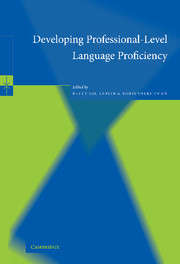Book contents
- Frontmatter
- Contents
- Notes on contributors
- Foreword
- Acknowledgments
- I Principles, practices, and theory
- II Programs
- 3 Contexts for advanced foreign language learning: a report on an immersion institute
- 4 Bridging the gap between language for general purposes and language for work: an intensive Superior-level language/skill course for teachers, translators, and interpreters
- 5 Learning Chinese in China: programs for developing Superior- to Distinguished-level Chinese language proficiency in China and Taiwan
- 6 Developing professional-level oral proficiency: the Shekhtman Method of Communicative teaching
- 7 The LangNet “Reading to the Four” Project: applied technology at higher levels of language learning
- 8 In the quest for the Level 4+ in Arabic: training Level 2–3 learners in independent reading
- 9 Teaching high-level writing skills in English at a Danish university
- 10 Heritage speakers as learners at the Superior level: differences and similarities between Spanish and Russian student populations
- 11 Teaching Russian language teachers in eight summer Institutes in Russian language and culture
- III Learners and users
- References
- Index
5 - Learning Chinese in China: programs for developing Superior- to Distinguished-level Chinese language proficiency in China and Taiwan
Published online by Cambridge University Press: 03 December 2009
- Frontmatter
- Contents
- Notes on contributors
- Foreword
- Acknowledgments
- I Principles, practices, and theory
- II Programs
- 3 Contexts for advanced foreign language learning: a report on an immersion institute
- 4 Bridging the gap between language for general purposes and language for work: an intensive Superior-level language/skill course for teachers, translators, and interpreters
- 5 Learning Chinese in China: programs for developing Superior- to Distinguished-level Chinese language proficiency in China and Taiwan
- 6 Developing professional-level oral proficiency: the Shekhtman Method of Communicative teaching
- 7 The LangNet “Reading to the Four” Project: applied technology at higher levels of language learning
- 8 In the quest for the Level 4+ in Arabic: training Level 2–3 learners in independent reading
- 9 Teaching high-level writing skills in English at a Danish university
- 10 Heritage speakers as learners at the Superior level: differences and similarities between Spanish and Russian student populations
- 11 Teaching Russian language teachers in eight summer Institutes in Russian language and culture
- III Learners and users
- References
- Index
Summary
The average lay person, if asked the best way to learn Chinese, would probably reply that one should go to China for a period of time and “pick up” the language naturally. For beginning students, learning Chinese in China is actually not the most efficient way to proceed. However, once students have reached the intermediate stage, there is widespread agreement that the fastest and best way for them to continue their language studies is to spend a substantial period of time in a Chinese-speaking region in close contact with Chinese speakers. In fact, it is questionable whether a non-native can attain Superior- to Distinguished-level (SD) proficiency in Chinese any other way.
However, simply living in China will almost certainly not result in the acquisition of SD-level language skills. Everyone is familiar with the example of expatriates who have lived in a country five, ten, twenty, or more years but possess little or no real proficiency in the language. Then there are other longtime foreign residents who can manage daily affairs well enough and may think of themselves as possessing “near-native” proficiency but actually stick to the simplest vocabulary and grammar and, even then, produce few utterances that are not without a major or minor error. It is the thesis of this chapter that, to achieve SD-level proficiency in Chinese, students require a combination of long-term immersion in Chinese culture with an organized training program that systematically pushes them up the proficiency ladder, a thesis that finds resonance in several chapters of this volume (e.g., Chapter 3).
- Type
- Chapter
- Information
- Developing Professional-Level Language Proficiency , pp. 96 - 118Publisher: Cambridge University PressPrint publication year: 2002
- 6
- Cited by

